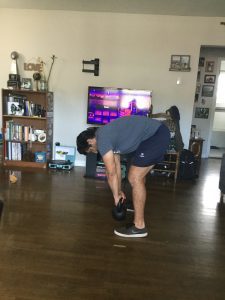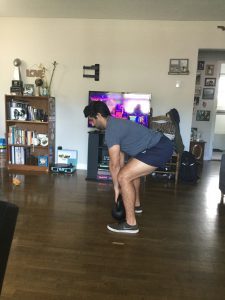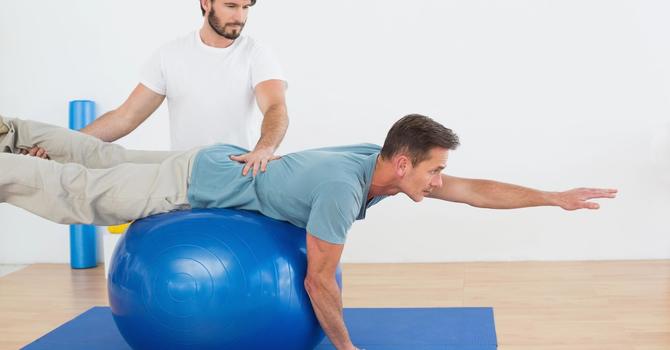Although there may be no scientific research that states more time at home equals more chores, it sure feels that way! But there is research behind the way we move during simple tasks and how we feel after. For example, picking boxes off the floor and back pain could likely mean you don’t hip hinge correctly. It’s imperative we make sure our lifting mechanics are sound when doing almost everything, from exercise to reaching for cleaning products under your sink.
The hip hinge is a foundational movement pattern where you learn to move the hips independently of the low back.
In simpler terms, think of the hip hinge as a way to load the spine safely in a neutral position that can help combat low back pain. This is also called “spine sparing” and directly influences the way you move!
Spine Sparing is a way to load the spine in a safe & neutral pattern.
There’s a high chance you haven’t heard the term “hip hinge,” but you more than likely perform a variation of this exercise every day. Learning how to hip hinge is a movement conditioning exercise that will allow you to build a strong mechanical foundation.
When you’re unfamiliar with how to hip hinge in everyday life, problems can occur during simple tasks such as gardening, picking up your kid, grocery shopping, or any hip dominant exercise at the gym. This term is called “spinal hinging” where you rely on bending at the low back, and not utilizing your hips.
Does this sound like you? If so, schedule a free call with one of our doctors to find out where your limitations are when it comes to hinging properly and how we can help you.
What Is A Hip Hinge?
A hip hinge is a functional movement pattern we use in our everyday lives. From sitting to standing, to picking up heavy objects off the ground, the hip hinge allows for optimal movement of our hips and low back.
The hip hinge is a movement (flexion & extension) through the hip joint, keeping a neutral spine, and knees slightly flexed. Learning how to harness this movement can help spare your low back, allow for safe movement in different situations, and allow you to repetitively lift heavy objects from the ground.
Spinal Hinging vs. Hip Hinging
It’s important to understand the difference between the two from a functional standpoint. In simple terms, spinal hinging typically looks like bending over with a very rounded back, where hip hinging keeps a neutral spine and you bend from your hips.
1) Example of Spinal Hinging

One of the most common functional deficits I see when assessing a patient with low back pain is the patient’s inability to hip hinge.
The typical trend is a patient with pain when bending forward (flexion intolerant) has a habit of hinging or bending at the lumbar spine (low back).
Enough volume of spinal hinging over time with excessive load can lead to future injury. Establishing a hip hinge pattern can help you learn how to move through your hips and at the same time make sure to have a neutral lumbar spine (low back).
2) Example of Hip Hinging
A hip hinge is a fundamental movement pattern that allows you to move through your hips in a safe & efficient way pattern. Your spine remains neutral (straight), and you move your hips back.

How To Perform A Hip Hinge:
The easiest way to think about performing a hip hinge is breaking it down into four simple steps:
- Maintain a Neutral Spine/ Abdominal Brace
- Maintain Soft Bend in the Knee( Knees don’t move anymore)
- Push your Hips Back while keeping your back straight.
- Squeeze your glutes to bring you back to the starting position
In the office we start to help groove the hip hinge using one or multiple progressions based on the patient’s ability to grasp the movement. There are plenty of ways to teach a hip hinge, and you have to find the right motor learning exercise for each patient.

Here are some ways that we build the hinge pattern in the office:
Quadruped Sit Back:
Glute Bridge:
Tall Kneeling Hip Hinge:
Using The Dowel:
KEY: DO NOT LET THE DOWEL COME OFF YOUR BACK WHEN PUSHING YOUR HIPS BACK. If this happens it means you are still bending at your low back as opposed to your hips.
Cable Pull Through:
Kettlebell Deadlift:
Why Learning To Hip Hinge Can Help Your Lower Back
If a patient has low back pain when bending forward, learning how to move by hip hinging can start to remove the painful motion/motor pattern (1). By introducing a pain-free movement, we can start to change a patient’s belief on pain & movement.
The patient now begins to gain confidence as they associate a decrease in pain with the enhanced movement (2). Now the patient is creating awareness for themselves as they can relate the pain to bending at the low back as opposed to bending with their hips.
By no means is learning how to hip hinge the cure for low back pain. Learning how to move in a pain free environment is one piece of the puzzle.
However, it is important to learn how to hip hinge so you can build confidence in yourself, and decrease the fear associated with daily living.
Difference Between A Squat & Hip Hinge
It’s important to understand the difference between these two functional movements because most clients in our office either don’t know how to hip hinge or squat their hinge.
Squatting your hinge basically means you’re using too much knee bend, and the movement looks more like a squat than a hinge.
Remember, a hip hinge moving through your hips and loading your posterior chain (glutes & hamstrings). There really is little to no knee movement when performing a hip hinge.
Yes, in the starting position you bend the knees softly and then the knees don’t move at all for the rest of the hip hinge.
The biggest difference is that the squat has your knees bending and shin going forward and the hinge keeps the shin vertical.
In the squat your trunk stays vertical and in the hip hinge your trunk goes at a 45 degree angle.
Check out this video to see the difference between a squat and hip hinge.
Hip Dominant Exercises Used At The Gym And In Everyday Life
Here’s a list of common exercises you may do at the gym or throughout your day that are hip dominant!
- Deadlifts
- Single Leg Dead Lifts (SLDL)
- Glute Bridges
- Kettlebell Swing
- Power Clean
- Gardening
- Lifting boxes off the ground
- Lifting up your kids
How Hip Hinging Should Be Used In Your Daily Life
Establishing a hip hinge can directly translate to improved movement efficiency in life. Whether we are bending over to pick up an object, heavy box, child, grandchild, or groceries, we are performing a hinge.
Learning how to perform this fundamental movement pattern can help translate from the gym to everyday life.
Let’s see those hips swing!
Think you need more personalized help with hip hinging properly or want to find out how you can get out of pain for good? Click below to schedule a free consultation with one of our Strive2Move doctors!




